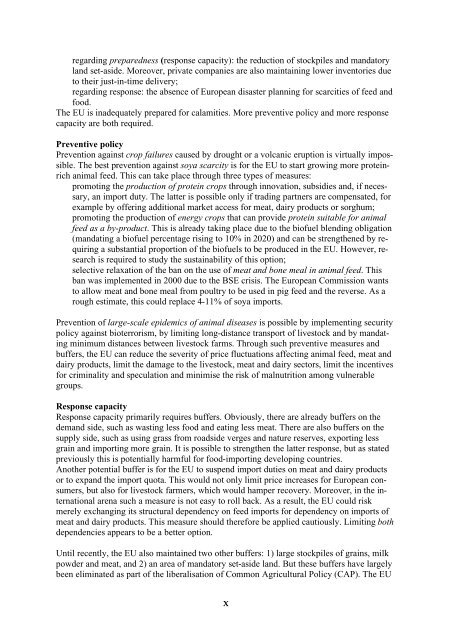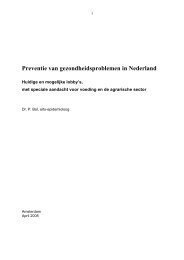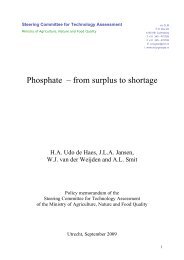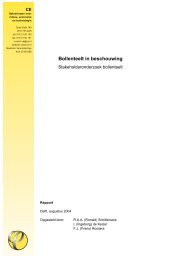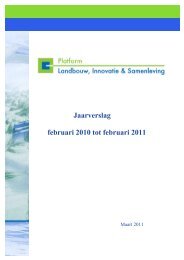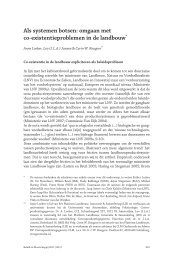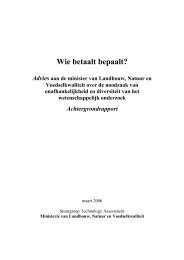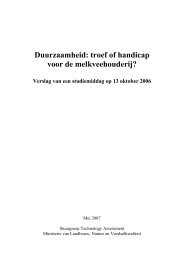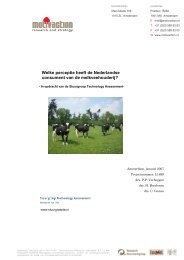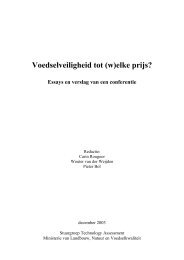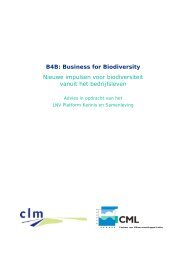De kwetsbaarheid van het Europese landbouw- en voedselsysteem ...
De kwetsbaarheid van het Europese landbouw- en voedselsysteem ...
De kwetsbaarheid van het Europese landbouw- en voedselsysteem ...
You also want an ePaper? Increase the reach of your titles
YUMPU automatically turns print PDFs into web optimized ePapers that Google loves.
• regarding preparedness (response capacity): the reduction of stockpiles and mandatory<br />
land set-aside. Moreover, private companies are also maintaining lower inv<strong>en</strong>tories due<br />
to their just-in-time delivery;<br />
• regarding response: the abs<strong>en</strong>ce of European disaster planning for scarcities of feed and<br />
food.<br />
The EU is inadequately prepared for calamities. More prev<strong>en</strong>tive policy and more response<br />
capacity are both required.<br />
Prev<strong>en</strong>tive policy<br />
Prev<strong>en</strong>tion against crop failures caused by drought or a volcanic eruption is virtually impossible.<br />
The best prev<strong>en</strong>tion against soya scarcity is for the EU to start growing more proteinrich<br />
animal feed. This can take place through three types of measures:<br />
• promoting the production of protein crops through innovation, subsidies and, if necessary,<br />
an import duty. The latter is possible only if trading partners are comp<strong>en</strong>sated, for<br />
example by offering additional market access for meat, dairy products or sorghum;<br />
• promoting the production of <strong>en</strong>ergy crops that can provide protein suitable for animal<br />
feed as a by-product. This is already taking place due to the biofuel bl<strong>en</strong>ding obligation<br />
(mandating a biofuel perc<strong>en</strong>tage rising to 10% in 2020) and can be str<strong>en</strong>gth<strong>en</strong>ed by requiring<br />
a substantial proportion of the biofuels to be produced in the EU. However, research<br />
is required to study the sustainability of this option;<br />
• selective relaxation of the ban on the use of meat and bone meal in animal feed. This<br />
ban was implem<strong>en</strong>ted in 2000 due to the BSE crisis. The European Commission wants<br />
to allow meat and bone meal from poultry to be used in pig feed and the reverse. As a<br />
rough estimate, this could replace 4-11% of soya imports.<br />
Prev<strong>en</strong>tion of large-scale epidemics of animal diseases is possible by implem<strong>en</strong>ting security<br />
policy against bioterrorism, by limiting long-distance transport of livestock and by mandating<br />
minimum distances betwe<strong>en</strong> livestock farms. Through such prev<strong>en</strong>tive measures and<br />
buffers, the EU can reduce the severity of price fluctuations affecting animal feed, meat and<br />
dairy products, limit the damage to the livestock, meat and dairy sectors, limit the inc<strong>en</strong>tives<br />
for criminality and speculation and minimise the risk of malnutrition among vulnerable<br />
groups.<br />
Response capacity<br />
Response capacity primarily requires buffers. Obviously, there are already buffers on the<br />
demand side, such as wasting less food and eating less meat. There are also buffers on the<br />
supply side, such as using grass from roadside verges and nature reserves, exporting less<br />
grain and importing more grain. It is possible to str<strong>en</strong>gth<strong>en</strong> the latter response, but as stated<br />
previously this is pot<strong>en</strong>tially harmful for food-importing developing countries.<br />
Another pot<strong>en</strong>tial buffer is for the EU to susp<strong>en</strong>d import duties on meat and dairy products<br />
or to expand the import quota. This would not only limit price increases for European consumers,<br />
but also for livestock farmers, which would hamper recovery. Moreover, in the international<br />
ar<strong>en</strong>a such a measure is not easy to roll back. As a result, the EU could risk<br />
merely exchanging its structural dep<strong>en</strong>d<strong>en</strong>cy on feed imports for dep<strong>en</strong>d<strong>en</strong>cy on imports of<br />
meat and dairy products. This measure should therefore be applied cautiously. Limiting both<br />
dep<strong>en</strong>d<strong>en</strong>cies appears to be a better option.<br />
Until rec<strong>en</strong>tly, the EU also maintained two other buffers: 1) large stockpiles of grains, milk<br />
powder and meat, and 2) an area of mandatory set-aside land. But these buffers have largely<br />
be<strong>en</strong> eliminated as part of the liberalisation of Common Agricultural Policy (CAP). The EU<br />
X


